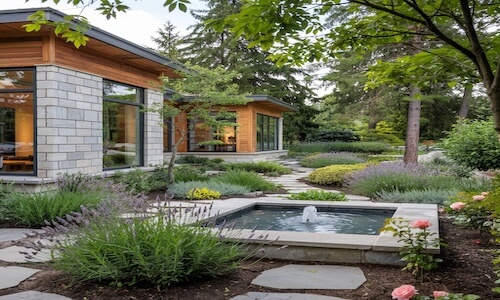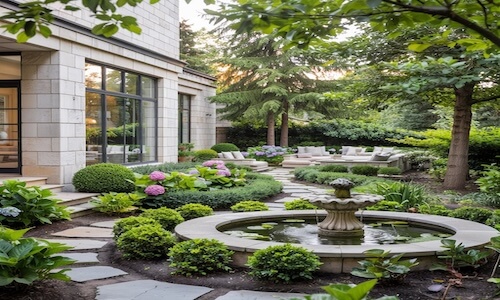Outdoor Space & Landscaping
Outdoor Space & Landscaping for Custom Homes: Designing Your Dream Yard
When building a custom home, people often focus heavily on interior design—floor plans, finishes, lighting—but the outdoor space is just as important. Your home’s exterior is the first thing people see, and more importantly, it’s the environment you live in. A thoughtfully designed outdoor space and landscape doesn’t just enhance curb appeal—it expands your living space, connects your home to nature, and boosts long-term property value.
Whether you’re dreaming of lush gardens, a serene patio, or an entertainer’s paradise with a pool and outdoor kitchen, landscaping is where a custom home truly comes to life. It’s the finishing touch—and for many, it’s where the best memories are made.

Why Landscaping Matters in a Custom Home
Your outdoor space isn’t just a yard—it’s an extension of your custom home. And when you’re designing from scratch, landscaping should be part of the master plan, not an afterthought. Here’s why:
- Functionality: Outdoor areas can provide additional square footage for entertaining, dining, relaxing, or even working.
- Curb Appeal: Landscaping is key to that “wow” factor when someone first sees your home.
- Environmental Benefits: Smart landscaping can improve drainage, reduce erosion, provide shade, and help with temperature regulation.
- Resale Value: A well-landscaped home can increase property value by as much as 10-15%, depending on the market.
- Personal Enjoyment: Most importantly, a beautiful yard adds to your everyday quality of life—whether you’re sipping coffee on a deck or enjoying a sunset around a fire pit.


Step 1: Start With a Master Plan
Just like your home’s architecture, your landscape needs a design plan. A cohesive plan ensures that everything from hardscaping (patios, walkways) to softscaping (plants, grass) flows together visually and functionally.
Work with a landscape designer or architect—especially if your lot has slopes, drainage issues, or unique features. They’ll assess your site, understand your goals, and develop a strategy that works with your budget, lifestyle, and local climate.
Ask yourself:
- How will we use the outdoor space?
- Do we want low-maintenance landscaping?
- Are we entertaining guests outdoors often?
- Do we need privacy or fencing?
- Do we want a pool, spa, or water feature?
- Will kids or pets use the yard?
Your answers will shape everything from layout to material choices.

Step 2: Divide the Space Into Zones
Treat your yard like a house with “rooms.” Zoning helps organize outdoor spaces by purpose. Common zones include:
- Entryway / Front Yard: Sets the tone and enhances curb appeal. Use lighting, paths, and plants to create a welcoming vibe.
- Backyard Living Area: This is the heart of most outdoor spaces. Think patios, decks, outdoor kitchens, fire pits, or lounge areas.
- Dining Area: Whether it’s a full kitchen setup or just a table and chairs under a pergola, dining al fresco is a must.
- Play Areas: Sandboxes, swing sets, trampolines, or even turf for running around—great for kids and pets.
- Garden Spaces: Flower beds, raised vegetable gardens, or native plant areas.
- Utility Spaces: Sheds, compost bins, HVAC units, and storage areas—best tucked out of sight but accessible.
Good zoning keeps the space functional, organized, and visually balanced.

Step 3: Choose Your Hardscaping Wisely
Hardscaping refers to the non-living elements of your landscape—patios, retaining walls, pavers, fences, and walkways. These elements add structure and function to your yard.
Popular materials include:
- Natural stone: Beautiful and timeless, but can be pricey.
- Concrete: Versatile and cost-effective, especially for modern designs.
- Pavers or bricks: Great for patios and paths, available in many styles.
- Wood: Often used for decks, pergolas, or fences, but needs regular maintenance.
Hardscaping also includes features like:
- Outdoor kitchens or built-in grills
- Fire pits or fireplaces
- Pergolas or shade structures
- Water features (ponds, fountains, pools)
Plan hardscaping early—it’s difficult and expensive to change later.

Step 4: Integrate Softscaping
Softscaping is everything that grows—plants, grass, trees, flowers, and shrubs. This is what softens your hardscaping and makes the space feel alive.
Here’s how to build a softscape that works:
- Choose native or climate-appropriate plants for lower maintenance and better survival.
- Layer your landscaping—start with taller trees in the back, medium-height shrubs in the middle, and smaller flowers or groundcover in front.
- Consider bloom times to keep your garden colorful across seasons.
- Mix textures and colors for visual interest.
- Include evergreens to keep things looking good year-round.
And remember—less can be more. A well-curated, simple planting plan is easier to maintain and can look more intentional than a crowded garden.

Step 5: Lighting, Irrigation & Sustainability
Don’t forget the infrastructure that keeps your yard running smoothly.
Outdoor lighting makes your yard usable at night and enhances safety and aesthetics. Use:
- Pathway lights for walkways
- Accent lighting for trees and architectural features
- String lights or lanterns for ambiance
Irrigation systems help your plants thrive without constant manual watering. Drip systems are water-efficient and great for gardens, while sprinklers are ideal for lawns.
Sustainable practices might include:
- Rainwater collection systems
- Xeriscaping (low-water landscaping)
- Permeable pavers to reduce runoff
- Pollinator-friendly plants like lavender, echinacea, and milkweed

Step 6: Personalize Your Outdoor Space
This is your space—make it feel like you. Add elements that reflect your hobbies, culture, and way of life.
Here are a few ideas:
- Backyard movie setup with a projector and screen
- Custom garden beds for herbs, veggies, or flowers
- Hammock nook between two trees
- Outdoor art like sculptures, murals, or mosaics
- Zen garden or meditation space
- Mini orchard with fruit trees
Adding personality turns your yard from something generic into something magical.

Maintenance Tips
Custom landscaping is an investment, and regular care keeps it looking great. Some homeowners hire professional services, while others handle it themselves. Either way, plan for:
- Seasonal planting and pruning
- Lawn care or turf management
- Mulching, fertilizing, and pest control
- Power-washing hard surfaces
- Checking irrigation and lighting systems
Choose plants and materials based on how much time you want to spend maintaining your yard.
